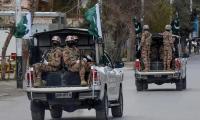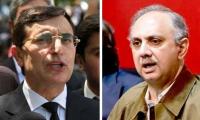The writer is a former adviser to the World Bank.
Pakistan’s health crisis could explode , gravely crippling its society, economy and national security, if the lockdown is lifted prematurely. The Almighty has been very kind to Pakistan so far. But let us not stretch our luck.
In a situation where the whole word is grappling with the unknown, and living on the edge, our substantial easing of the lockdown is a dangerous strategy. It is being driven by the misplaced views of the economic team that “we cannot have a prolonged lockdown as we are poor and can only afford a modest relief programme”. A safer and lower risk option for Pakistan is to expand the Ehsaas and business relief programme, extend the lockdown for at least another month, and as far as practicable enforce social distancing and wearing of homemade masks in markets.
The lockdown could be eased in calibrated steps, once we have aggressive testing and tracking in place, the curve has been sufficiently flattened and we have the confidence that the remaining incidence of disease can be comfortably managed by our health system.
Extending the lockdown would increase the suffering of the poor , and further depress economic activity. To counter that, the Ehsaas programme should be significantly expanded. The aim should be to provide Rs10,000 per month, for 2-3 months, to around 30 million poor and low-income households, comprising daily wagers, subsistence farmers, and workers of SMEs in retail, service and manufacturing sectors – the people around the poverty line, who have the ability to come out on the streets and create unmanageable social unrest. This programme would cost perhaps an additional Rs1 trillion, over and above the already approved corona relief package. As discussed later, the cost of the expanded and on-going relief package is within Pakistan’s reach.
The whole world, other than Pakistan, is pursuing the strategy of ‘Think Big, Spend Whatever it Takes, Take Risks and Act Fast’. The government must think out of the box, and not succumb to the economic team’s views which are beholden to the IMF dogma, and totally inappropriate for handling a pandemic crisis.
The prime minister must show gutsy leadership, and immediately instruct his team to revise the design and scope of the following two relief initiatives. The Ehsaas cash handout programme should be massively expanded and simplified. The current programme design reflects the anti-poor bias, so ingrained in our thinking and governmental processes. In Pakistan, if you are poor you need to go through five filters, then biometric, then queue and then grapple to get a meagre Rs12,000 cash handout. But if you are a rich and powerful person owning textile, sugar, fertilizer or IPP businesses, you get hundreds of billions of subsidies without any filters or biometrics. Imagine if these wealthy people were asked to queue out in the open, and get biometrics for their subsidies or refunds.
The current Ehsaas scheme, other than BISP, must be changed substantially. The majority of the 80 million people who have sent SMSs seeking cash handouts can safely be assumed to comprise the 30 million poor/low income household. The government should announce that of these 80 million SMS senders, cash handouts will be given to everyone having an average monthly scratch card usage of Rs100-150 per month – across all SIMs held by one person. Monthly scratch card phone usage is a good surrogate for quickly identifying the poor/low income . Even if some ‘non-poor’ slip into the net, now is not the time to fine-tune targeting.
Since each of these 80 million people has a SIM card, which is linked to a CNIC, in a matter of a few days, mobile companies can identify those CNICs that have an average monthly scratch card usage of less than Rs100-150 per month. BISP beneficiaries would be excluded from this list, for they are already receiving a cash subsidy, but their subsidy should also be temporarily increased to Rs10,000 per month. In addition, using the NADRA family tree, the government can limit the cash handout per family to Rs10,000 per month. So if several people in the same family have sent SMSs, the total cash given to the family will be limited to Rs10,000.
Unlike the current scheme whereby people have to queue and fight it out to get to the cash window, and which has led to flagrant violation of social distance, under the proposed scheme funds would be transferred through a mechanism like Easypaisa, Mobicash, etc. There will be no biometrics, no queuing, no leakage.
The scheme should provide subsidy for at least 2-3 months . The first month payment would be made simply on the basis of scratch card usage. Subsequent monthly payments could be made after application of other filters (eg ownership of movable/immovable assets, etc ) using information in the NADRA database. In announcing the scheme, the government would make it clear that if somebody cheats they would face jail term.
The other relief initiative which needs overhaul is the SBP’s bizarre low-interest loan scheme to encourage businesses to keep employees on their rolls. Obviously, the SBP is unaware that out of the three million or so retail, service and manufacturing businesses, which account for 80 percent of non-agricultural employment, only around 300,000 or so have a loan. It doesn't require a high IQ to ask why on earth the 2.7 million businesses would borrow now – when the future is so uncertain and bleak – when they have never borrowed in good times. Any sane businessman would shun borrowing like a plague at this time.
If the government wants to protect employment, then the present scheme is a non-starter. It should be turned into an outright unconditional grant scheme, at least for the SMEs which account for the bulk of employment. Employees would be identified based on EOBI data which would be cross-checked with information provided by the businesses through a simple mechanism, and funds would be transferred directly to the employee’s bank account. Once again, since employee CNIC would be the identifying metric, this would avoid double dipping – one CNIC holder benefitting from this and the above Ehsaas scheme.
Irrespective of the impact on the budget deficit or public debt of this additional Rs1 trillion (and the several hundred billions of the corona relief programme announced earlier), and even if it violates the IMF programme, Pakistan must implement these two schemes. A substantial portion of the Rs1.6-1.7 trillion (existing and proposed corona relief package) could be financed through debt relief, especially of the expensive Chinese loans, reduction of SBP policy rate to low single digit, cutback of wasteful expenditures, relief from IPPs, and a moderate and easily collectible one-time wealth tax on the rich. The un-financed gap would be filled by printing money.
Pakistan can always fix a bad macroeconomic balance sheet, but Pakistan cannot take the risk of the health crisis getting out of hand, as that would most certainly lead to a major economic contraction and social upheaval. The government must do “ Whatever it Takes” so the poor and low income can adequately feed their families for a few months, along with fighting the health crisis through prolonged lockdown, social distancing and strengthening the health system.
The prime minister should stop listening to the myopic economic team, and its misrepresentation that Pakistan is poor and can only afford the current half-hearted relief programme. Traditional economic theory is irrelevant when fighting a pandemic. We should also stop listening to the IMF for the next six months; if it really wanted to help us, it would have given us at least $8-10 billion, rather than just enough money so Pakistan could pay back their upcoming loan payment.
The government should be bold and increase the relief package by another Rs1 trillion. There will be some leakages, corruption and poor targeting, but this is not the time to worry about such stuff. Deficits and public debt will balloon, and maybe inflation might increase – though it is unlikely to get out of hand since aggregate demand has crashed. We can correct all the macroeconomic imbalances, if we achieve victory over the virus.
MPAs ask for their salaries and benefits to be at par with high court judges and exempt from tax
This system fosters and places premium on VIPs, facilitating VIP culture, which is alive and kicking
Imagine this waste covering over 15,500 cricket stadiums, piled three meters deep every year
If there is one thing that can be gleaned from politics today, it is that we no longer speak same language
Postman argues that “typographic mind” was yielding to “televisual mind”
Pakistan is well poised to meet opportunities that Artificial Intelligence will offer for developments in industries







